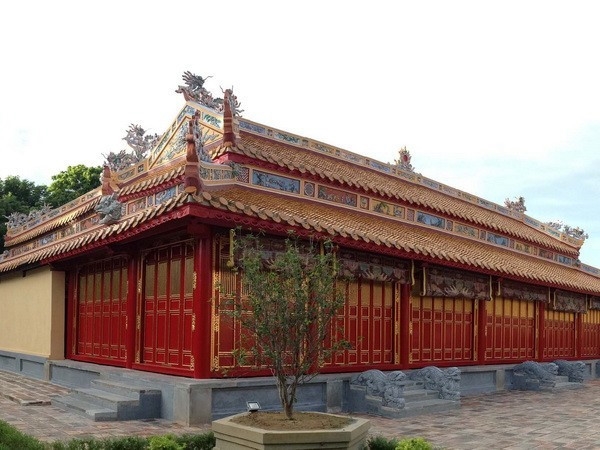Director of the Center for Research and Promotion of Cultural Heritage Values Nguyen Duc Tang said that the British Council has been at the forefront of this support through its Connections Through Culture program.
The council has provided technical and financial assistance for nine projects nationwide, ranging from empowering Mong women in Hoa Binh through traditional crafts to reviving the silk-making craft in Nghe An.
    |
 |
|
The restoration of Trieu To temple within Hue's Imperial Citadel is backed by a substantial 700,000 USD grant from the U.S. Ambassadors Fund for Cultural Preservation. |
The results have been remarkably promising, demonstrating how effectively leveraged international resources can yield tangible outcomes, he underscored.
Hue city has led the nation in cultural preservation on the back of international organizations, having orchestrated partnerships with 15 governments, 50 non-governmental organizations, and over ten international consulting organizations to implement dozens of research and restoration projects. Among the most notable achievements is the restoration of Trieu To temple within Hue's Imperial Citadel, backed by a substantial 700,000 USD grant from the U.S. Ambassadors Fund for Cultural Preservation, one of the organization's largest commitments in Vietnam.
Director of the municipal Department of Culture and Sports Phan Thanh Hai stated that international cooperation projects bring not only capital but also technology transfer and professional training.
Over the past two decades, the fund has financed 16 projects in Vietnam worth a combined 1.2 million USD, helping revive both tangible and intangible cultural assets.
Cultural Attaché at the embassy Kate Bartlett highlighted that the fund’s mission is not only to preserve architecture but also to protect folk songs, customs and traditions that form Vietnam’s unique identity.
The global commitment to Vietnam's heritage spans continents. India has contributed over 50 billion VND (1.89 million USD) to the conservation of the My Son Sanctuary in Da Nang city. France has worked with Hanoi to preserve colonial-era villas, maintaining pockets of French architectural legacy amid the modern urban landscape.
UNESCO has provided research support, documentation assistance, and technical consultation, playing a pivotal role in securing recognition for Hue royal court music, ca tru (ceremonial singing), and Mother Goddess worship as Intangible Cultural Heritage of Humanity. Meanwhile, the Republic of Korea and European Union have engaged in preservation projects nationwide.
These efforts have gradually shifted Vietnam’s preservation model from mere restoration to sustainable management that links heritage protection with local economic development. Knowledge exchange between international experts and domestic conservationists accelerates restoration timelines.
However, Chairman of the Vietnam Cultural Heritage Association Do Van Tru pointed out several challenges to international cooperation in the area, including inconsistent domestic coordination, hurdles in mechanisms and policies, and shortage of skilled professionals to acquire advanced techniques.
Against the backdrop, he suggested Vietnam expand its network of partners, pay due attention to human resources training, develop transparent policies and a solid legal framework to ensure smooth coordination and efficient use of funds.
Source: VNA